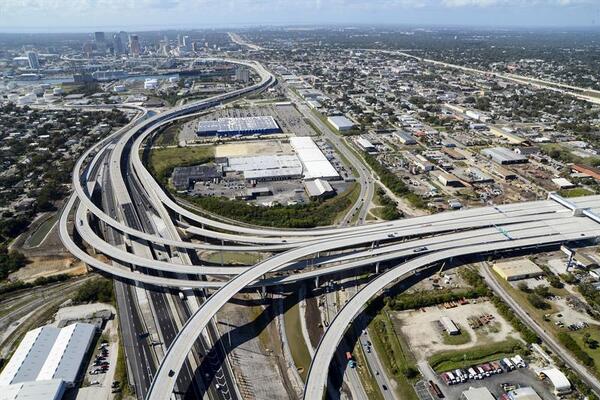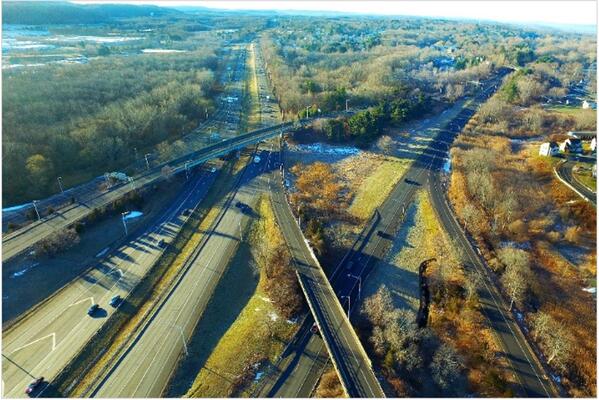Featured Projects

I-4/Selmon Expressway Connector
Tampa, FL
Project Details
I-4/Selmon Expressway Connector

Client: Florida Department of Transporation
Construction Cost: $398M
Key Facts:
- Design-Bid-Build
- Provides direct access between I-4 and Selmon Expressway, removing traffic from local roadways
- Built in highly congested urban areas next to and over railroads, roads, and buildings
- Includes 35 separate bridge structures and widenings
- Extensive utility relocation and maintenance of traffic
This interchange was constructed as part of Tampa’s interstate system to improve traffic movement and safety for motorists. The interchange connects the Selmon Expressway (also designed by GM2’s Complex Bridge team) to I-4, providing an important trucking connection and transportation improvement. The new interchange provides direct access for trucks on I-4 to the Port of Tampa, relieving traffic from Historic Ybor City.
The project consists of 35 separate bridge structures and widenings, constructed using a variety of construction methods and materials (precast segmental, bulb-t). Piers are rectangular, with a maximum height of 50’. The project was built in a highly congested urban area that is next to and over various railroads, roadways and buildings. The foundations consist of large diameter drilled shafts. Extensive utility relocation and maintenance of traffic was performed to allow for the construction of these bridges.
GM2’s Complex Bridge team designed 9,086’ of the concrete segmental portion of this major interchange (six bridges). Segmental boxes range from approximately 30’ to 64’ in width. The total project bridge deck is 1.5 million square feet. The GM2 Complex Bridge team provided precast segmental superstructure design, segmental geometry for casting, and construction engineering services to Florida DOT during construction.

I-91 NB/I-691 EB Interchange Improvements - Design-Build Owners Representative
Meriden, CT
Project Details
I-91 NB/I-691 EB Interchange Improvements - Design-Build Owners Representative

Client: CTDOT
Construction Cost: $60M
Key Facts:
- Structural Engineering
- Highway Engineering
- Traffic Engineering
- Permitting
- Design-Build Specifications
- Construction Phase Services
GM2 is serving as the owner’s representative for this Design-Build project encompassing the I-691EB to I-91NB Interchange improvements. Project 0079-0245 addresses operational and safety concerns associated with capacity, congestion and weaving at the I-691 eastbound to I-91 northbound interchange. The project entails approximately 2.1-miles of highway, including pavement rehabilitation, roadway safety improvements, repair/rehabilitation of 4 bridges, rehabilitation and widening of one, and replacement of one. Illumination will be upgraded, drainage improved, and signage replaced. As the owner’s representative, GM2 is developing 30% design documents, specifications, and design-build proposal documents, as well as all preliminary permitting.
This project has been selected, at GM2’s recommendation, for implementation under current budgetary constraints, but it is actually one part of a larger, $300M project for major interchange improvements at this location.

Relocated Route 403
East Greenwich & North Kingstown, RI
Project Details
Relocated Route 403



Client: RIDOT
Construction Cost: $140M
Key Facts:
- Highway Engineering
- Drainage Design
- Traffic Engineering
- Environmental
- Utilities
- Pedestrian Facilities
- Stakeholder Coordination
- Public Outreach
- Construction Phase Services
The relocated Route 403 project entailed the design of a new freeway extending form Route 4, north of Frenchtown Road in East Greenwich, to the Quonset Business Park in North Kingstown, RI. The distance of the freeway is approximately 4½ miles, not including several additional miles of interchange ramps and new roadways, which comprise a total of 14.8 miles of roadway on the project. The scope of work included thirteen bridges; the relocation of existing streets and roadways, including a half-mile relocation of Post Road (U.S. Route 1); six permanent and two temporary traffic signalized intersections; construction of temporary roadways and bridges; and extensive facilities for controlling storm water runoff and for protecting groundwater aquifers and freshwater wetlands.
The project’s location being within the watersheds of eight distinct watercourses, one being the Hunt River, a sole-source aquifer and major source of water for the towns of Warwick and East Greenwich in Kent County, required the preparation of a comprehensive Environmental Impact Statement (EIS). The conceptual design phase was most critical to the project because the freeway corridor traverses these watersheds.
Following a major study involving options for the sequencing and scheduling of multiple construction contracts, GRA recommended a program that ultimately involved the advertising of eleven separate construction contracts. Services for the final design efforts of the separate contracts was completed under a master plan that allowed the new freeway to be built over a period of several years under multiple construction contracts, all controlled by specific annual budgets.
With respect to storm water management, the project design included the following:
- Evaluating over two square miles of watershed within the Towns of North Kingstown and East Greenwich. These watersheds included portions of the Hunt River, Fry Brook, Frenchtown Brook, Pine River, Sand Hill Brook and Mill Creek.
- Quantitative hydrologic analysis on the existing and proposed watersheds and the development of a drainage system to prevent adverse impacts to adjacent and downstream floodplains, water surface elevations, water quality and groundwater.
- Hydrologic analysis included the determination of peak discharge rates for the 2-, 10-, 25- and 100-year storm events; the calculation of stream profiles and flood elevations; the design of approximately 13 miles of closed drainage systems; the design of channels and swales, including impervious-lined (with bentonite) ditches for the containment of sodium-tainted runoff from the new freeway to prevent infiltration into the groundwater; the design of ten water quality basins; and the creation of new wetland areas to compensate for the unavoidable filling of existing wetlands.
- Preparation of all State and Federal environmental regulatory permits.